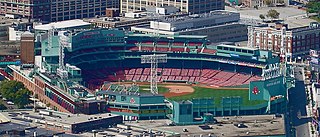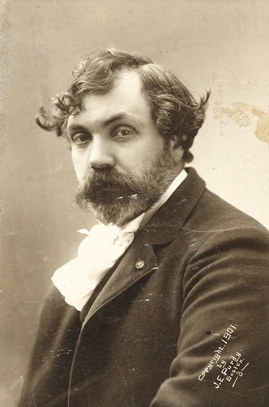
John Winthrop was an English Puritan lawyer and a leading figure in the founding of the Massachusetts Bay Colony, the second major settlement in New England following Plymouth Colony. Winthrop led the first large wave of colonists from England in 1630 and served as governor for 12 of the colony's first 20 years. His writings and vision of the colony as a Puritan "city upon a hill" dominated New England colonial development, influencing the governments and religions of neighboring colonies in addition to those of Massachusetts.

Winthrop is a town in Suffolk County, Massachusetts, United States. The population was 19,316 at the 2020 census. Winthrop is an ocean-side suburban town in Greater Boston situated at the north entrance to the Boston Harbor, geographically nearby to the Logan International Airport. It is located on a peninsula, 1.6 square miles (4.2 km2) in area, connected to the city of Revere, Massachusetts by a narrow isthmus and to multiple portions of Boston by a bridge over the harbor inlet to the Belle Isle Marsh Reservation in the neighborhood of East Boston, a shared line at the Boston Logan International Airport, and at Deer Island.

The Boston Brahmins, or Boston elite, are members of Boston's historic upper class. From the late 19th century through the mid-20th century, they were often associated with a cultivated New England accent, Harvard University, Anglicanism, and traditional British-American customs and clothing. Descendants of the earliest English colonists are typically considered to be the most representative of the Boston Brahmins. They are considered White Anglo-Saxon Protestants (WASPs).

Thomas Dudley was a New England colonial magistrate who served several terms as governor of the Massachusetts Bay Colony. Dudley was the chief founder of Newtowne, later Cambridge, Massachusetts, and built the town's first home. He provided land and funds to establish the Roxbury Latin School and signed Harvard College's new charter during his 1650 term as governor. Dudley was a devout Puritan who opposed religious views not conforming with his. In this, he was more rigid than other early Massachusetts leaders like John Winthrop, but less confrontational than John Endecott.

The Back Bay Fens, often simply referred to as "the Fens," is a parkland and urban wild in Boston, Massachusetts, United States. It was established in 1879. Designed by Frederick Law Olmsted to serve as a link in the Emerald Necklace park system, the Fens gives its name to the Fenway-Kenmore neighborhood.

Fenway–Kenmore is an officially recognized neighborhood of Boston, Massachusetts. It is considered one neighborhood for administrative purposes, but it is composed of numerous distinct sections that are almost always referred to as "Fenway", "the Fenway", "Kenmore Square", or "Kenmore".

The Boston, Revere Beach and Lynn Railroad was a 3 ft narrow-gauge passenger-carrying shortline railroad between East Boston and Lynn, Massachusetts, from 1875 to 1940. Part of the railroad's right of way now forms the outer section of the Massachusetts Bay Transportation Authority's Blue Line rapid transit service.

The Public Garden, also known as Boston Public Garden, is a large park in the heart of Boston, Massachusetts, adjacent to Boston Common. It is a part of the Emerald Necklace system of parks and is bounded by Charles Street and Boston Common to the east, Beacon Street and Beacon Hill to the north, Arlington Street and Back Bay to the west, and Boylston Street to the south. The Public Garden was the first public botanical garden in America.

Henry Hudson Kitson was an English-American sculptor who sculpted many representations of American military heroes.

Arbella or Arabella was the flagship of the Winthrop Fleet on which Governor John Winthrop, other members of the Company, and Puritan emigrants transported themselves and the Charter of the Massachusetts Bay Company from England to Salem between April 8 and June 12, 1630, thereby giving legal birth to the Commonwealth of Massachusetts. John Winthrop is reputed to have given the famous "A Model of Christian Charity" sermon aboard the ship. Also on board was Anne Bradstreet, the first European female poet to be published from the New World, and her family.

James Ripley Osgood (1836–1892) was an American publisher in Boston. He was involved with the publishing company that became Houghton Mifflin.
John Appleton Brown was an American landscape painter working largely in pastels and oils, born in West Newbury, Massachusetts. He showed talent at an early age and studied under Emile Lambinet in France. For many years he worked and showed in Boston, summering in his native northeastern Massachusetts and painting his best known lyrical landscapes there. In 1891 he and his wife, noted artist Agnes Augusta Bartlett Brown, moved to New York City, where he died on January 18, 1902.

The Boston Flower Exchange is a wholesale flower market located in Boston, Massachusetts. Founded as a marketplace that local growers could rent cooperatively to sell their products in a space more suited to their needs than Boston's historic Haymarket open-air marketplace, it has been the focal point of the floral trade of New England for over a hundred years. Although originally a local growers' wholesale market, the Flower Exchange now features flowers and foliage from dozens of countries and has expanded to carry potted plants, glassware, pottery and other floral supplies. The Flower Exchange is not open to the public and is limited to members of the trade only.

Dock Square in downtown Boston, Massachusetts, is a public square adjacent to Faneuil Hall, bounded by Congress Street, North Street, and the steps of the 60 State Street office tower. Its name derives from its original (17th-century) location at the waterfront. From the 1630s through the early 19th century, it served boats in the Boston Harbor as "the common landing place, at Bendell's Cove," later called Town Dock. "Around the dock was transacted the chief mercantile business of the town." After the waterfront was filled in during the early 19th century, Dock Square continued as a center of commerce for some years. The addition in the 1960s of Government Center changed the scale and character of the square from a hub of city life, to a place one merely passes through. As of the 1950s the square has become largely a tourist spot, with the Freedom Trail running through it. John Winthrop, coming from Salem where he landed as a Puritan from England, ended up "setting up a dock at the head of the cove, and here began the town of Boston, which soon was recognized as the political and economic center of the [Massachusetts Bay] colony.

Frank Hill Smith (1842–1904) was an American artist and interior designer based in Boston, Massachusetts. He painted landscapes and figures; and designed wall frescos, stage curtains, stained-glass windows, and other décor. Among his works are ceiling frescoes in the Representatives Hall in the Massachusetts State House.

Adams Square (1879–1963) was a square in downtown Boston, Massachusetts. Now demolished, it was formerly located on the site of the current Boston City Hall in Government Center.

John Winthrop is a marble sculpture of John Winthrop by Richard Saltonstall Greenough, installed in the United States Capitol, in Washington D.C., as part of the National Statuary Hall Collection. It is one of two statues donated by the state of Massachusetts. The statue was accepted in the collection by George Frisbie Hoar on December 19, 1876.

A statue of poet Robert Burns by Henry Hudson Kitson is installed along The Fens in Boston's Fenway–Kenmore neighborhood, in the U.S. state of Massachusetts. Between 1975 and 2019, it stood in Boston's Winthrop Square.




















